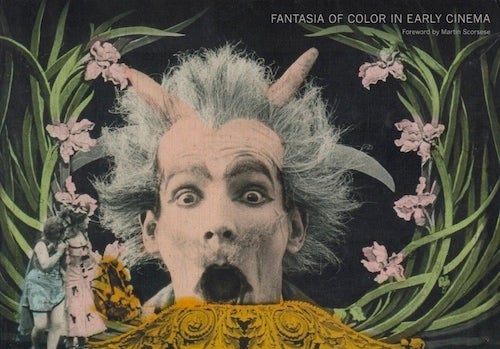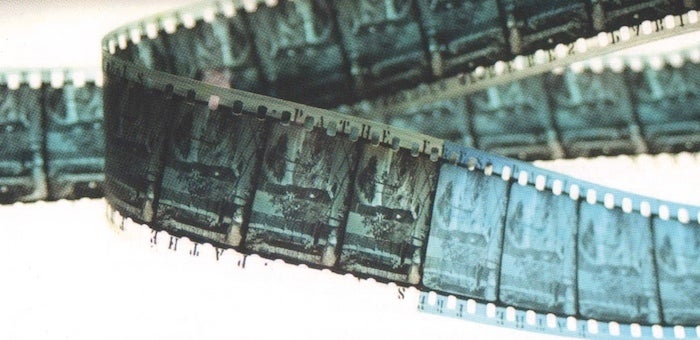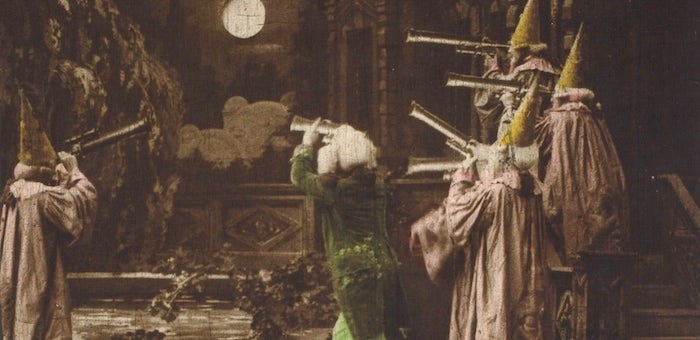
2015 has been a banner year for new research on color film and for lushly illustrated books on the history of color film technologies. The spring brought us George Eastman House’s fabulous coffee table-sized study of the Technicolor Company in its founding years to the establishment of the three-color Technicolor process. This summer came the breathtaking reproductions of hand and stencil-colored frames from 100+ year old films, Fantasia of Color in Early Cinema (EYE Filmmuseum / Amsterdam University Press). Credited as authors are Tom Gunning, Joshua Yumibe, Giovanna Fossati and Jonathon Rosen, with a filmography contributed by Elif Rongen-Kaynakçi. The publication appeared in conjunction with an academic conference on early cinema’s tinting, toning and hand coloring, held at the EYE Film Institute in Amsterdam in early April.
But before I get into the merits of the book, I want to refer readers to the back pages, where EYE and the University of Amsterdam Press note the following about the new series, Framing Film:
"Framing Film is a book series dedicated to theoretical and analytical studies in restoration, collection, archival, and exhibition practices … With this series, Amsterdam University Press and EYE aim to support the academic research community, as well as practitioners in archive and restoration."
I, of course, applaud this effort, because for me the construction of film history has always been a complex matrix of social forces, academic research interest, and archival availability. Just as research queries by film scholars lead to films being prioritized for preservation and restoration, preservation initiatives in the archives also lead to an opening up of new film historical terrain. One of the best examples of that dynamic was the 1978 Brighton FIAF conference and its symposium on surviving films from 1900-1906, which led to a whole new field of film historical study, focused on early and transitional cinema.

One of the young scholars invited to present a paper in Brighton was Tom Gunning, whose essay on “The Cinema of Attractions” must be one of the most quoted articles in all film studies. For this volume, Gunning, who is Professor at the University of Chicago, contributes the first essay, “Applying Color: Creating Fantasy of Cinema,” which argues that early cinema vacillated between realism (actualités) and fantasy, and that the extremely bright hues of applied color, whether tinting or stencil coloring, contributed to early cinema’s predilection for the uncanny.
Interestingly, Assistant Professor Joshua Yumibe notes in his essay, “Techniques of the Fantastic,” that applied color was associated as much with non-fiction films, as it was with trick and fairy films, or dance films. He also drills down on the technology of dyes, demonstrating that the invention of aniline-based dyes revolutionized the look of our early 20th-century environment, a rainbow of color bursting forth into the previously monochromatic world of fashion, in lithographic posters, in magic lantern slides, in wallpaper, in hand-colored photographs, and in color printing for books, magazines and newspapers.

EYE’s chief curator, Giovanna Fossati – whose book on film restoration, From Grain to Pixel, has become a standard text in the field – discusses film restoration issues in her piece, “The Archival Life of Early Color Films: Restoration and Presentation.” After laying out some general problems when preserving ancient 35mm nitrate prints, she contrasts various analog and digital preservation methods used at EYE and other archives to preserve the original color, in particular the “Desmet Method,” which allows for the creation of color prints from a black and white negative.
Jonathon Rosen declares in his short text and accompanying collage of images that he was fascinated by technical drawings detailing image production and by the aesthetic power of early color moving images. He also explains the process for selecting the visual avalanche that follows. Indeed, the last three-quarters of the book consists of full-page color reproductions of amazing beauty, clarity (due to digital reproduction and enhancement) and sophistication, again belying the fact that early cinema was “primitive.”

Giovanna Fossati clues us at the end of her essay on how we should approach these images, namely as a “pensive spectator, who can reflect on the cinema.” And indeed, each of the 197 frame enlargement deserve to be contemplated, losing oneself in the details of costuming, color bursts and physiognomies. There is a loose thematic structure, moving from dreams to fairytales, from metamorphoses to voyages, but it is the visual overdose that makes this book such a pleasure.
All images from Fantasia of Color in Early Cinema (EYE Filmmuseum / Amsterdam University Press, 2015)
< Back to Archival Spaces blog






 Mobile Navigation
Mobile Navigation

